Toshiba Portege R835: Less Ultra, More Notebook
by Dustin Sklavos on March 30, 2012 11:35 AM EST- Posted in
- Laptops
- Intel
- Toshiba
- Sandy Bridge
- Notebooks
Battery Life
Where the Toshiba Portege R835 really benefits from Sandy Bridge and excels over its predecessor is in running time on the battery. Toshiba lists the battery life for the R835 as approximately nine hours, a hurdle we were actually able to clear pretty easily at idle.
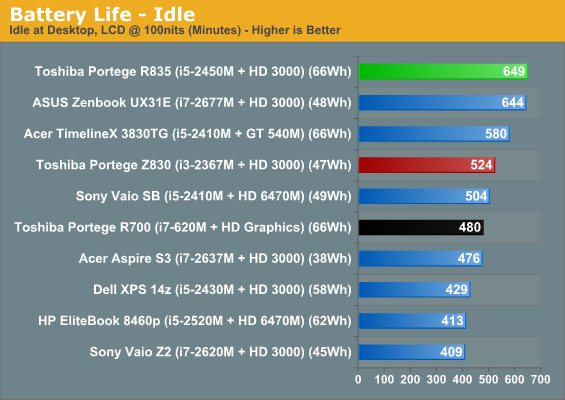
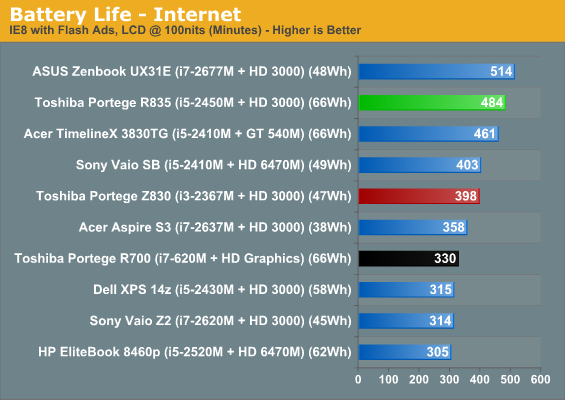
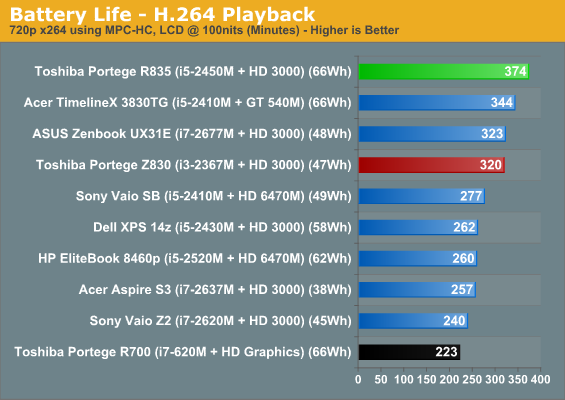
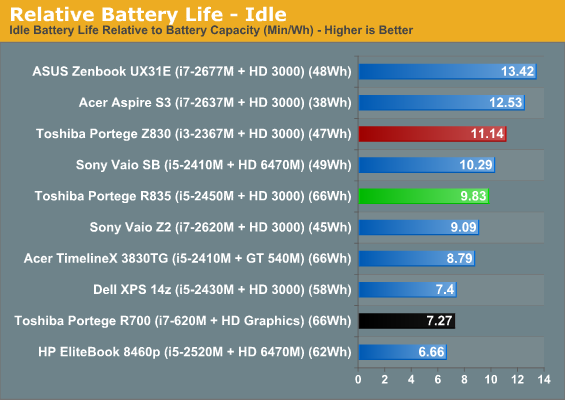
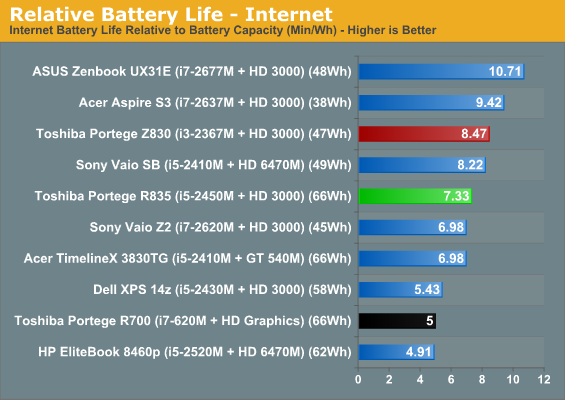
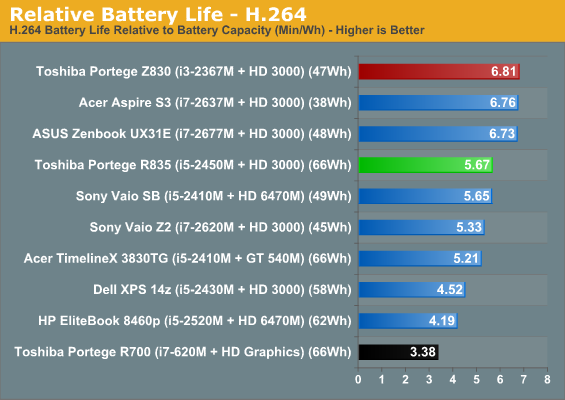
From our test results it's reasonable to assume an end user could hit that nine hour mark if they're willing to sacrifice some display brightness, or if they turn off the wireless once in a while. The Portege R835 also again demonstrates something we've been aware of for a while now: Sandy Bridge is just plain more power efficient than Arrandale. Given we're essentially looking at an updated R700, Sandy Bridge vs. Arrandale ends up with Sandy Bridge offering 35% more idle battery life, 47% more Internet battery life, and a massive 68% more video playback battery life. I makes us wonder how much further Intel can take things with Ivy Bridge, but we'll find out soon enough.
Heat and Noise
Fortunately, the high-pitched whine of the fan noise in many ultrabooks and particularly machines like Sony's Vaio Z2 isn't replicated in the Portege R835; Toshiba's notebook, even under heavy load, isn't actually that obtrusive.

Ignoring HWMonitor misreading the CPU model number, we can see there's a very good reason why fan noise isn't a huge issue with the Portege R835: the processor is basically cooking itself. This is a situation that's basically inexcusable and prevents me from making a recommendation full-stop. I was concerned thermals would prevent the i5-2450M from hitting its turbo clocks consistently after seeing these results, but apparently it's not an issue...the chip just runs very hot in this notebook.
While it's true modern processors take care of themselves to avoid burning out, I still can't help but feel like these kinds of thermals are a warranty call waiting to happen. Once dust starts accumulating in that fan it's going to be game over. This heat doesn't directly translate to the keyboard or the bottom surface of the notebook, but it's there and worthy of concern. Anecdotally, we've seen several older laptops that erred on the side of silence rather than cooling that developed serious issues over time—Jarred in fact just helped someone with a Core 2 Duo laptop that was shutting down and running horribly slow thanks to dust buildup. If you do buy a laptop like this, we definitely recommend regular dust cleanouts with compressed air, at least a couple times per year.










81 Comments
View All Comments
damianrobertjones - Saturday, March 31, 2012 - link
"I think you guys pay too much attention to the high end. Maybe you should start doing reviews on more mainstream models that people actually BUY"+1. The site might get a whole new flood of people paying a visit. I don;t know five people that would even THINK about spending over £600 on a laptop as it's ALL around the basement price.
SongEmu - Saturday, March 31, 2012 - link
If you're in the market for a super cheap notebook, you're probably not an Anandtech regular. And even if you are, you're not reading reviews on your craptop. You're typically ticking off check boxes, i.e.:dual core proc
DVD drive
HDD > 120 GB
X inch monitor.
Done.
There is nothing exciting under $600. not for notebooks.
ScottHavens - Friday, March 30, 2012 - link
I saw the resolution was only 1366x768 on a 13.3" display and just skipped the rest.ScottHavens - Friday, March 30, 2012 - link
I gave in and read the rest of the review; I see that my complaint has been addressed by the author. When will it get addressed by the manufacturers?rudolphna - Friday, March 30, 2012 - link
Such snobs people are anymore. So this is basically the same thing as my previous post, but did you not realize that 99% of laptops sold to actual normal consumers are 1366x768, both in 14" and 15.6" versions? At the price point, maybe you should not complain. And seriously? 768 in a 13.3" screen isn't good enough? My my my.welshy992 - Friday, March 30, 2012 - link
768p in a 15.6 inch screen is really bad. You can't do anything useful with that. The resolution is so cramped. You can't even open an entire word document or a web page without always having to scroll. Did you not realize that 99% of laptops sold USED to have a higher vertical resolution than 768p?If all you do on your laptop is Facebook, watch movies, and play games, then yes 768p in a 15.6 inch form factor is fine. For spreadsheets, coding, word docs, or any other form of content creation it is not worth it. I'd rather chain myself to a desk with an external monitor like I'm doing right now.
Coup27 - Friday, March 30, 2012 - link
rudolphna this is quite clearly a enthusiasts website by enthusiasts. The people who walk into bestbuy and buy a $400 laptop with a 1366x768 TN LCD with a 5,400rpm HDD and think it's great because they have no knowledge to say otherwise. These people will also not be reading Anandtech. I don't want Anandtech to read like a BBC Technology review or equivilent.I also disagree with you on another point. Long before SSDs we had to accept the performance from a 5400rpm HDD. Now, it's quite clear that this performance for any user who knows how to use a laptop to its potential, is crap.
rudolphna - Friday, March 30, 2012 - link
Well considering that I AM an enthusiast, and I have a desktop using Anandtech recommended components (2500k, P8Z68-V Pro, Crucial M4, Fractal Design Define R3 etc) I understand the point of view. However there are enthusiasts like me, that don't need or want a high end laptop.My aforementioned laptop IS 768p, and I can do everything you just mentioned, perfectly fine. Sure I have to scroll. That's not really a big deal to me. Well, except coding.
Anandtech does reviews of low end PSUs, and laptops with A6s, etc. But they do the most expensive ones they can find. Anandtech may be an enthusiast site, but it wouldn't hurt to do a mainstream review every now and again.
YES the SSD is fast. But for what I need my laptop to do, I don't NEED one. Nor do 99% of people who buy laptops who the most intensive thing they will do is facebook games. If you keep your laptop clean and running light, as I do, I have no problems with a standard 5,400RPM drive. Granted, I'm pretty sure that Western Digitals 5400RPM drives are faster than Toshiba and Hitachis, but that' s beside the point.
steven75 - Friday, March 30, 2012 - link
If you're happy with a junky, poor performing laptop, more power to you. But don't expect most enthusiasts to agree with you. It's odd that you think they will.TrackSmart - Friday, March 30, 2012 - link
I respectfully disagree. I personally don't need to see lots of reviews of the cookie-cutter $400 laptops you describe. Maybe one or two examples per year, just to set the benchmark for what you get for that price point. If one of them breaks the mold in an important way, then yes, review it. But otherwise, why bother? I can describe most of them to you already.That's not snobbery. I also agree that these $400 laptops it will do everything that the average person needs to do. But they occupy a part of the market where there profits are so low that there is little room for differentiation between models.